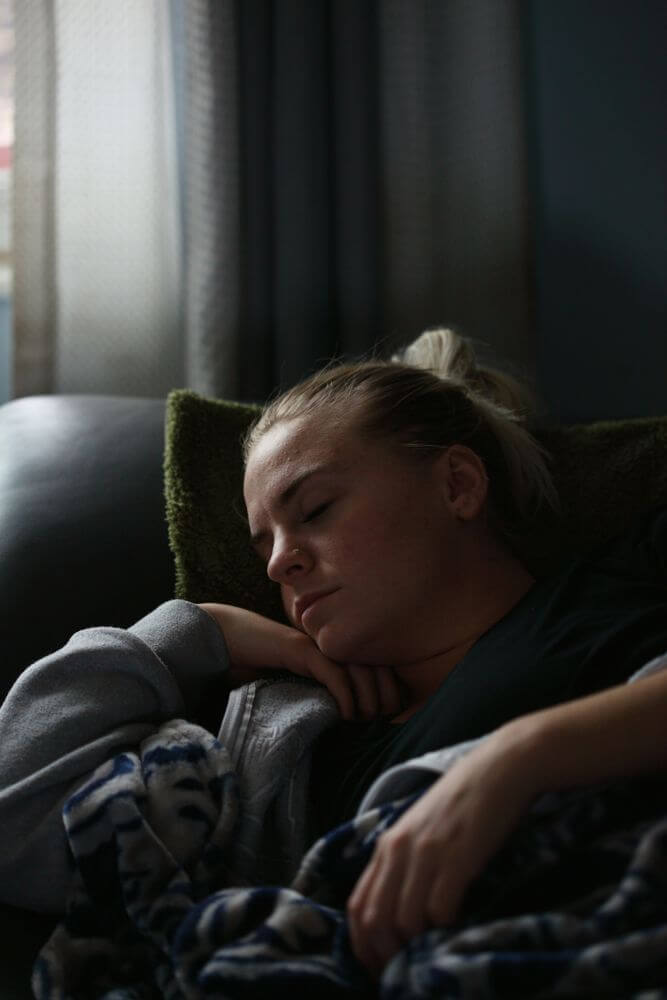What Are the 34 Symptoms of Perimenopause?

Discover the 34 symptoms of perimenopause and how they can affect your daily life. Stay informed and take proactive steps towards better health!
Summary
- During perimenopause, your levels of oestrogen and progesterone decrease gradually. These hormones help regulate many of your body's systems and when hormones fluctuate, they can produce some noticeable and life-disrupting symptoms. Some women will transition into menopause without much disturbance, while others can develop symptoms that are so severe they can impact their physical, emotional and mental health.
- Every woman will experience the transition to menopause differently. However, one of the first signs most notice is perimenopause periods. When progesterone levels start to drop, the endometrium can no longer stick to the uterus walls, which is why women can experience such unpredictable bleeding. Heavy bleeding can also occur shortly before menopause as oestrogen levels rise before falling. The production of progesterone and oestrogen will continue to go down, which is when you reach menopause.
- Some of the most common perimenopause symptoms include hot flushes, mood swings, fatigue, low libido and vaginal dryness. There are many ways to manage these symptoms through lifestyle choices - such as exercise, diet, and some medical methods like hormone replacement therapy (HRT).
- There are also some slightly less common perimenopause symptoms which are worth being aware of. For example, bad odour from the hot flushes, vision issues due to dry eyes, skin problems, hair loss, cold flushes in response to excessive sweating, and change in taste.
Introduction
Perimenopause (also known as menopause transition) is the time during which your ovaries gradually reduce oestrogen production. For most women, it tends to start in their 40s, but for some women, the age perimenopause starts is around their 30s.
Usually, perimenopause lasts for four years, but it may also only go on for a few months or up to ten years. The end is marked by the start of menopause, which starts once a woman has gone for 12 months in a row without having a period.
Perimenopause is viewed as a transition period because ovaries prepare to stop releasing eggs. Then, during the last year or two, the drop in oestrogen starts to speed up. During this stage, many women experience symptoms we associate with menopause, but are actually symptoms of perimenopause.

Because your levels of oestrogen and progesterone decrease, your body can no longer successfully regulate temperature and you may experience spotting or heavy bleeding, which are among the most well-known perimenopausal symptoms.
The hormone progesterone helps the tissue inside the uterus (known as the endometrium) stick to the walls, which helps with pregnancy. However, when the levels of progesterone start to drop, the endometrium can no longer stick to the uterus walls, which is why women can experience such unpredictable bleeding.
Some perimenopausal women experience a change in their periods up to a decade before reaching actual menopause. A hormonal contraceptive, such as an IUD or "the coil", can help control vaginal bleeding. It contains a synthetic version of progesterone which helps to keep the lining of the uterus sticking to the uterus wall.

What other perimenopause signs can you expect apart from apparent changes in periods?
Common perimenopause symptoms
Hot flushes
What is perimenopause if not the time in a woman's life when she's battling hot flushes? It is estimated that between 50% and 85% of women over the age of 45 will experience them. Scientists are still not entirely sure what causes hot flushes, but they do know it is connected to hormonal changes which are occurring during the menopausal transition.
Mood swings
The mood swings experienced during perimenopause can go beyond irritability and feeling a bit low. Several extensive studies have shown an increased risk of developing depression during perimenopause. One of the best ways to help manage mood swings is by generally looking after yourself, getting the eight hours of recommended sleep per night, eating healthy food and exercising regularly. All the changes going on with the body can be challenging for some women to handle. It is important to remember these symptoms are caused by hormones and not necessary surroundings, so it might not be a job, partner or general life causing the mood swings.
Sleep problems
Having problems falling and staying asleep is a true tell-tale sign of perimenopause. This is due to hormonal changes, hot flushes, lower levels of melatonin and mental health. Staying active, practising a calming bedtime routine and including meditation can help. You can also reach for insomnia medications, but these are usually only used as a last resort.
Fatigue
Bad sleep can lead to fatigue and a constant feeling of tiredness. Some of our clients have successfully overcome these two perimenopause symptoms with the right dose of HRT. You can read more about it in this interview.
Heart palpitations
Heart palpations can feel like your heart is racing, or has an irregular beat for a few seconds. Although this sounds like an alarming symptom, it's just a manifestation of low oestrogen levels. However, if you have a family history of heart disease, it’s important to talk to your doctor about them.
Weight gain
With age, our metabolism slows down and with lower levels of oestrogen your body starts to not just gain weight but store it around your middle region. Since it will be harder to gain muscle mass in menopause, women are encouraged to do weight training in perimenopause to prepare their bodies for the Change.
Fragile bones
Lower levels of oestrogen can lead to a loss of bone density. In some cases, this could lead to osteoporosis, so doctors recommend getting a bone density test. This symptom is another reason to work on building your muscles so that they can better support your bones.
Diminished libido
One of the most common perimenopause symptoms is definitely diminished libido. The same hormones that control our menstrual cycles, control the libido as well, which is why sexual desire takes a back seat during your perimenopause.
Vaginal dryness
This can be a very uncomfortable condition, but there are some treatments to help. One popular method is to use a local oestrogen treatment that comes in a gel or pessary. These can help with oestrogen levels and are considered safer than hormone replacement therapy (HRT) which affects the whole body.
Breast soreness
We might have some good news. Although breast soreness is one of the most common premenopausal signs, it usually goes away in the later stages of menopause.
Urinary weakness
As the levels of oestrogen decrease, women can experience urinary incontinence as the urinary tract contains oestrogen. Using local oestrogen gels or treatments can help alleviate the symptoms, but it is worth working on preventing this problem rather than trying to cure it. This is one of the reasons why doing regular pelvic floor exercises is so worthwhile. Of course, there is only so much pelvic floor exercises you can do, especially if you've given birth. Many women suffer from bladder problems for years before perimenopause but are too embarrassed to seek help. It is worth getting this issue sorted before oestrogen levels drop, as the condition will only get worse.
Headaches
If you are prone to experiencing headaches during PMS, you will be more prone to experiencing them in perimenopause as well.
Memory problems
Hormonal changes, bad sleep and overall bad mood can lead to some memory problems. This was how our client Adelle found out she was in premature menopause. Read more about her menopause journey in this interview.
Brain fog
Research suggests that around 60% of women experience brain fog during menopause. It can be a great inconvenience, especially while at work, but this symptom can be helped with the right dose of HRT.
Anxiety
With so many changes to your body and emotional state, it's no wonder your anxiety might increase as a result of perimenopause. You can try implementing some lifestyle changes like quitting smoking, reducing caffeine and alcohol intake and spending more time outside, as well as exercising to bring down your anxiety levels.
Unusual Perimenopause Symptoms

We have gone through some of the most commonly reported perimenopause symptoms, but as mentioned, every woman's experience is different. The body is going through a complex time of transition, and some may have some unusual symptoms. Here are some of the more uncommon symptoms:
Bad odour
The fluctuating oestrogen levels trick the body into thinking it is overheating. This excessive sweating and hot flushes can cause some inconvenient body odour. As a result, some women find they will need to take more frequent showers and stick to natural fabrics.
Vision issues
Hormones can also affect ocular tissue composition. This causes changes in tear production which can cause dry, scratchy eyes and a change in vision. However, there are some eye drops which can help alleviate discomfort, but they should be closely monitored to ensure you are looking after your eye health.
Dizziness
Lower oestrogen levels lead to a drop in insulin production, making it hard to keep your blood sugar levels stable. That's why perimenopausal women often experience dizzy spells.
Skin problems
With the lowered oestrogen levels, skin can become dry and thin, making perimenopause a time when existing skincare routines need to be adjusted to suit the changing skin needs. It is also possible for chin hair to start coming through, and bruising can occur more easily.
Hair loss
Many men experience hair loss as they age, and this is also true for some women during perimenopause. This can also be due to inherited androgenic alopecia which can be triggered during this time. There are some great hair products which can help stimulate growth and help hide thinning areas.
Brittle nails
Along with skin and hair issues, your nails may also be impacted by the hormone disbalance of perimenopause. This is caused by the lower levels of keratin in your body.
Electric shock
Just like heart palpitations, electric shock is a symptom you'll only feel for a few seconds. But the difference is that they may not be localized. Seeing how hormones impact nerve function, it's possible that a lack of them triggers a painful sensation.
Cold flushes
Most people are familiar with perimenopause hot flushes, but some women also experience cold flushes. The body sometimes responds to the excessive sweating needed to reduce body temperature by suddenly triggering a cold flash.
Taste changes
The drop in oestrogen also decreases mucus production. This change can cause a dry mouth and can alter taste buds. Although this can be annoying, it can be used as an opportunity to try new foods and make some healthier diet choices.
Bleeding gums
Since oestrogen regulates inflammation, perimenopause can cause some problems with your gums as they will be more likely to get inflamed. In order to prevent this, make sure to floss regularly.
Burning mouth
A fleeting sensation of your mouth being on fire can also be a nasty symptom of perimenopause. It can be paired with numbness, tingling and tenderness.
Digestive issues
Bloating and constipation can occur due to low levels of progesterone, which acts as a natural diuretic. This may cause you to make some changes to your diet.
Cholesterol
Declining oestrogen levels may lead to an increase in your blood cholesterol levels, especially the bad cholesterol, which contributes to an increased risk of heart disease.
Urge to conceive
It is still possible to get pregnant during perimenopause, and some women find their biological clock letting them know this is their last chance to have a baby.
Frozen shoulder
Although not one of the common perimenopause symptoms, a frozen shoulder can indicate that the Change is close. Read more about this in our interview with Tara.
Paresthesia
Paresthesia is the feeling of numbness or the sensation of pins and needles that you might get in your arms, hands, legs, feet etc. A good treatment would be anything that helps your blood circulation - working out, massage, acupuncture.
Itchy ears
With lower oestrogen levels, your ear wax might become dry, leading to itching and more buildup. That's why it's important to properly hydrate and irrigate your ears if necessary.
Tinnitus
Tinnitus is the unpleasant ringing in your ears, which might be caused by a hormonal imbalance.
Allergies
If you have any allergies, you might experience a worsening of your symptoms during perimenopause. This is sometimes caused by spikes in histamine.
 Take control of your perimenopause
Take control of your perimenopause
As you can see, perimenopause can significantly impact your daily life – including your relationships, family, social life and work. However, with knowledge of the symptoms women experience during this sometimes lengthy transition, we can learn ways to support ourselves and others around us.
Our research shows that women age twice as fast during perimenopause because the hormones that keep chronic inflammation at bay have decreased significantly. That's why we urge women to test their biological ages and find out how to optimise their lifestyles in order to stay younger for longer.
You can start by taking our health quiz!
Frequently Asked Questions (FAQs)
What are the first signs of perimenopause?
One of the earliest things you may notice as your body enters perimenopause is a change in the length of your menstrual cycle. Other common signs include hot flushes, sleep problems, inability to focus and mood swings. These are all common symptoms as hormones start to play havoc with your body.
Can I take anything for perimenopause?
There are plenty of methods for helping with perimenopause symptoms, including natural approaches and medications. One popular treatment is hormone therapy which involves systemic oestrogen therapy. This comes in pill, skin patch, spray, gel or cream form. It is presently one of the most effective treatment options for relieving perimenopausal symptoms.
What do perimenopause periods look like?
Perimenopausal periods will be slightly different for every woman. Some may experience spotting between periods, abnormally heavy bleeds, change in period colour (such as brown or dark blood), shorter or longer cycles, missed cycles and other irregularities.
Does perimenopause make you feel weird?
Many women indeed feel weird when going through perimenopause. This is often down to mood swings, irritability or feeling depressed during the lead-up to menopause. In addition, these physiological symptoms can be caused by the sleep disruptions associated with hot flushes, which are triggered by hormonal changes.
How do you survive perimenopause?
There are lots of ways you can make perimenopause a less painful experience. The first suggestion is to arm yourself with knowledge, as you will better understand what to expect and less likely to catch you off guard. Be sure to follow a healthy diet and lifestyle, which includes regular exercise, eating a balanced diet, good sleep habits, managing stress levels and becoming clued up on potential treatments – such as hormone therapy.
How long does perimenopause last?
Perimenopause usually lasts anywhere between 2 to 10 years.


